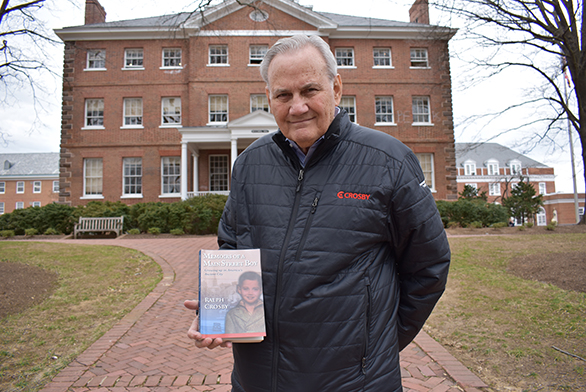A Walk Through History
February 28, 2017 | By Tim Pratt

Ralph Crosby remembers vividly running around the St. John’s College campus when he was growing up in Annapolis.
The college was a five-minute walk from his third-floor apartment on Main Street, through a narrow alley, over the State House grounds and across College Avenue.
Crosby learned to play tennis on clay courts where Francis Scott Key Auditorium now stands; he played basketball in Iglehart Gymnasium; softball games took place on the field adjacent to the gym; and the athletic field down the hill, next to College Creek, was the site of pick-up football games.
“This was one of my childhood playgrounds,” Crosby said during a recent afternoon on campus.
The history of Annapolis, St. John’s and life in America during the mid-20th century is detailed in Crosby’s new book, “Memoirs of a Main Street Boy: Growing up in America’s Ancient City.” He will speak about that history March 29 at St. John’s as part of the Maryland History Lecture Series. The event was originally scheduled for March 14, but was postponed due to inclement weather.
Crosby moved to Main Street when he was 4 years old. His father was a metal worker at the neighboring Naval Academy.
Downtown Annapolis was a lot different back then. The storefronts on Main Street have generally stayed the same, Crosby says, but the businesses behind those storefronts have changed.
Restaurants he remembers from his childhood have since moved or gone out of business; there were two 5- and 10-cent stores, which have long since closed. Three or four small grocery stores, along with jewelers, milliners, a pawn shop, clothing stores and a gas station at the bottom of Main Street also are gone.
Many of the apartments above those Main Street businesses were occupied by working-class families.
Now, Main Street is full of newer restaurants and bars. Many stores sell knick-knacks, sweet treats and clothing geared toward visitors. Even the traffic flow is different, from two-way operations to one-way.
“Main Street was really a town center in terms of a place where people who lived there would shop,” Crosby says. “It wasn’t a tourist attraction. It didn’t become so until many, many years later.”
While Main Street changed, St. John’s has remained largely the same, Crosby says, from its physical appearance to the great books program, which began in 1937—the year he moved downtown.
Crosby recalls heading into the ground floor of McDowell Hall to use the facilities, bouncing lacrosse balls off the World War I monument near College Avenue and playing near the memorial to French soldiers by Hodson Boathouse. Many other buildings on the historic campus also appear the same.
But there have been some changes.
What is now Greenfield Library used to be the Maryland Hall of Records; Francis Scott Key Auditorium and Mellon Hall used to be tennis courts and fields; the Liberty Tree, which stood for more than 400 years, was felled by a hurricane in 1999; new dorms have been built on the back of campus.
Although Crosby relied on his memory for many of the personal anecdotes in the book, he also spent time revisiting campus and working through the Maryland Archives to research the rest of it. Crosby used his writing background to complete the book. He had a lengthy journalism career before starting his own marketing company, Crosby Marketing Communications, which began operations in 1973 and is headquartered in Annapolis.
The book took two years of research and writing to complete.
“There was some nostalgia involved,” Crosby says. “I remembered my parents and some of the things we did together. Also, to delve into the history of Annapolis was fascinating.”
The book provides a look at what life was like in a small town from the end of the Great Depression through World War II and the Cold War.
Crosby recalls rationing and metal and paper drives; he remembers people getting their entertainment from movies and radio, before TV and the internet; and he recalls segregation in Annapolis and throughout much of the country.
“The book isn’t just a ‘look at me’ kind of thing,” Crosby says. “I really dig into some of the history and issues Annapolis faced, along with the rest of the country.”
Crosby’s lecture is sponsored by the Friends of St. John’s College and Anne Arundel County Trust for Preservation. It is free and open to the public.

